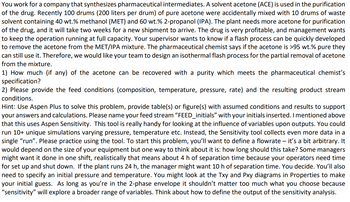
Introduction to Chemical Engineering Thermodynamics
8th Edition
ISBN: 9781259696527
Author: J.M. Smith Termodinamica en ingenieria quimica, Hendrick C Van Ness, Michael Abbott, Mark Swihart
Publisher: McGraw-Hill Education
expand_more
expand_more
format_list_bulleted
Question

Transcribed Image Text:You work for a company that synthesizes pharmaceutical intermediates. A solvent acetone (ACE) is used in the purification
of the drug. Recently 100 drums (200 liters per drum) of pure acetone were accidentally mixed with 10 drums of waste
solvent containing 40 wt.% methanol (MET) and 60 wt.% 2-propanol (IPA). The plant needs more acetone for purification
of the drug, and it will take two weeks for a new shipment to arrive. The drug is very profitable, and management wants
to keep the operation running at full capacity. Your supervisor wants to know if a flash process can be quickly developed
to remove the acetone from the MET/IPA mixture. The pharmaceutical chemist says if the acetone is >95 wt.% pure they
can still use it. Therefore, we would like your team to design an isothermal flash process for the partial removal of acetone
from the mixture.
1) How much (if any) of the acetone can be recovered with a purity which meets the pharmaceutical chemist's
specification?
2) Please provide the feed conditions (composition, temperature, pressure, rate) and the resulting product stream
conditions.
Hint: Use Aspen Plus to solve this problem, provide table(s) or figure(s) with assumed conditions and results to support
your answers and calculations. Please name your feed stream "FEED_initials" with your initials inserted. I mentioned above
that this uses Aspen Sensitivity. This tool is really handy for looking at the influence of variables upon outputs. You could
run 10+ unique simulations varying pressure, temperature etc. Instead, the Sensitivity tool collects even more data in a
single "run". Please practice using the tool. To start this problem, you'll want to define a flowrate - it's a bit arbitrary. It
would depend on the size of your equipment but one way to think about it is: how long should this take? Some managers
might want it done in one shift, realistically that means about 4 h of separation time because your operators need time
for set up and shut down. If the plant runs 24 h, the manager might want 10 h of separation time. You decide. You'll also
need to specify an initial pressure and temperature. You might look at the Txy and Pxy diagrams in Properties to make
your initial guess. As long as you're in the 2-phase envelope it shouldn't matter too much what you choose because
"sensitivity" will explore a broader range of variables. Think about how to define the output of the sensitivity analysis.
Expert Solution
This question has been solved!
Explore an expertly crafted, step-by-step solution for a thorough understanding of key concepts.
Step by stepSolved in 2 steps with 4 images

Knowledge Booster
Recommended textbooks for you
 Introduction to Chemical Engineering Thermodynami...Chemical EngineeringISBN:9781259696527Author:J.M. Smith Termodinamica en ingenieria quimica, Hendrick C Van Ness, Michael Abbott, Mark SwihartPublisher:McGraw-Hill Education
Introduction to Chemical Engineering Thermodynami...Chemical EngineeringISBN:9781259696527Author:J.M. Smith Termodinamica en ingenieria quimica, Hendrick C Van Ness, Michael Abbott, Mark SwihartPublisher:McGraw-Hill Education Elementary Principles of Chemical Processes, Bind...Chemical EngineeringISBN:9781118431221Author:Richard M. Felder, Ronald W. Rousseau, Lisa G. BullardPublisher:WILEY
Elementary Principles of Chemical Processes, Bind...Chemical EngineeringISBN:9781118431221Author:Richard M. Felder, Ronald W. Rousseau, Lisa G. BullardPublisher:WILEY Elements of Chemical Reaction Engineering (5th Ed...Chemical EngineeringISBN:9780133887518Author:H. Scott FoglerPublisher:Prentice Hall
Elements of Chemical Reaction Engineering (5th Ed...Chemical EngineeringISBN:9780133887518Author:H. Scott FoglerPublisher:Prentice Hall
 Industrial Plastics: Theory and ApplicationsChemical EngineeringISBN:9781285061238Author:Lokensgard, ErikPublisher:Delmar Cengage Learning
Industrial Plastics: Theory and ApplicationsChemical EngineeringISBN:9781285061238Author:Lokensgard, ErikPublisher:Delmar Cengage Learning Unit Operations of Chemical EngineeringChemical EngineeringISBN:9780072848236Author:Warren McCabe, Julian C. Smith, Peter HarriottPublisher:McGraw-Hill Companies, The
Unit Operations of Chemical EngineeringChemical EngineeringISBN:9780072848236Author:Warren McCabe, Julian C. Smith, Peter HarriottPublisher:McGraw-Hill Companies, The

Introduction to Chemical Engineering Thermodynami...
Chemical Engineering
ISBN:9781259696527
Author:J.M. Smith Termodinamica en ingenieria quimica, Hendrick C Van Ness, Michael Abbott, Mark Swihart
Publisher:McGraw-Hill Education

Elementary Principles of Chemical Processes, Bind...
Chemical Engineering
ISBN:9781118431221
Author:Richard M. Felder, Ronald W. Rousseau, Lisa G. Bullard
Publisher:WILEY

Elements of Chemical Reaction Engineering (5th Ed...
Chemical Engineering
ISBN:9780133887518
Author:H. Scott Fogler
Publisher:Prentice Hall


Industrial Plastics: Theory and Applications
Chemical Engineering
ISBN:9781285061238
Author:Lokensgard, Erik
Publisher:Delmar Cengage Learning

Unit Operations of Chemical Engineering
Chemical Engineering
ISBN:9780072848236
Author:Warren McCabe, Julian C. Smith, Peter Harriott
Publisher:McGraw-Hill Companies, The